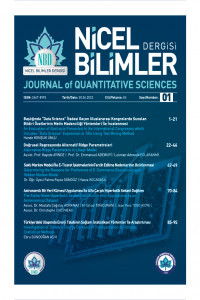HALKIN GÜNEŞ PANELLİ EVLERE YÖNELİK TUTUMLARININ ARAŞTIRILMASI: BİR YAPISAL EŞİTLİK MODELLEMESİ
Bu çalışmanın amacı, halkın güneş panelli evlere yönelik bakış açıları, tutumları ve satın alma niyetine etki eden faktörleri önerilen bir Yapısal Eşitlik Modeliyle (YEM) araştırmaktır. Bu amaçla önce, literatür taraması yardımıyla bir araştırma modeli tasarlanmış ve modeldeki ilişkileri sınamak için çeşitli hipotezler oluşturulmuştur. Daha sonra öne sürülen hipotezleri test edebilmek için veri toplama aracı geliştirilmiştir. Araştırma modelinde yer alan faktörler, Tutum, Sosyal Norm, Algılanan davranış kontrolü, Satın alma niyeti ve İlave ücret ödemeye yönelik gönüllülüktür. Çalışmada, önerilen araştırma modeli Yapısal Eşitlik Modellemesi (YEM) kullanılarak analiz edilmiş ve önerilen modelinin uygunluğu çeşitli uyum ölçütlerine göre değerlendirilmiştir. Analiz sonuçlarından, güneş panelli evlere yönelik aile ve çevreden gelen sosyal baskıdaki bir birimlik artışın, satın alma niyetinde 0,48 birimlik bir artışa neden olacağı belirlenmiştir. Ayrıca, algılanan davranış kontrolündeki bir birimlik artışın, güneş panelli evlere satın almaya yönelik ilave ücret ödeme gönüllüğünde 0,33 birimlik bir artışa neden olacağı da ortaya çıkmıştır.
Anahtar Kelimeler:
güneş panelli evlere, halkın tutumları, yapısal eşitlik
___
- Ajzen, E., & Fishbein, M. (1980). Understanding attitudes and predicting social behavior. Englewood Cliffs, NJ: Prentice Hall.
- Ajzen, I. (1991). The theory of planned behavior. Organizational Behavior and Human Decision Processes, 50, 179-211. http://dx.doi.org/10.1016/0749-5978(91)90020-T
- Ajzen, I., & Madden, T. J. (1986). Prediction of goal-directed behavior: attitudes, intentions, and perceived behavioral control. Journal of Experimental Social Psychology, 22, 453-474. http://dx.doi.org/10.1016/0022-1031(86)90045-4
- Başaran, K. (2013). Bulanık Mantık Kontrollü Otonom ve Şebeke Bağlantılı Rüzgar-Güneş Hibrid Güç Sisteminin Optimizasyonu ve Adnan Menderes Üniversitesi Kampüs Alanında Uygulanması, Doktora Tezi, Güneş Enerjisi Anabilim Dalı, İzmir, 131 .
- Başaran, K., Börekçi, S. (2013). 150 kW Şebeke Bağlantılı Çatı Kurulumlu Fotovoltaik Sistem Fizibilitesi, 2. Güneş Sempozyumu, Antalya.
- Chan, R. Y. K., & Lau, L. B. Y. (2000). Antecedents of green purchases: a survey in China. Journal of Consumer Marketing, 17(4): 338-357. http://dx.doi.org/10.1108/07363760010335358
- Cook, A. J., Kerr, G. N., & Moore, K. (2002). Attitudes and intentions towards purchasing GM food. Journal of Economic Psychology, 23, 557-572. http://dx.doi.org/10.1016/S0167-4870(02)00117-4.
- Çiftçi, A.& Kırbaş, İ.& İşyarlar, B.(2014),”Güneş Pili Kullanılarak Burdur’da Bir Evin Ortalama Elektrik İhtiyacının Karşılanması”, Mehmet Akif Ersoy Üniversitesi Fen Bilimleri Enstitüsü Dergisi, 5 (1):1309-2243.
- Desteknoloji, (2001). Yenilenebilir Enerji Kaynakları, DESTEKnoloji, (Sonbahar-2001).
- Fekadu, Z., & Kraft, P. (2001). Self-identity and in Planned Behavior Perspective: past behavior and its moderating effects on self-identity-intention relations. Social behavior and personality, 29(7), 671-686. http://dx.doi.org/10.2224/sbp.2001.29.7.671
- Fielding, K. S., McDonald, R., & Louis, W. R. (2008). Theory of planned behavior, identity and intentions to engage in environmental activism. Journal of Environmental Psychology, 28, 318-326. http://dx.doi.org/10.1016/ j.jenvp.2008.03.003.
- Gürbüz, H. & Yılmaz, V.(2018), Üniversite Öğrencilerinin Naylon Poşet Kullanımına İlişkin Tutum ve Davranışlarının Yapısal Eşitlik Modellemesiyle Araştırılması, Sosyoekonomi, 26(38): 135 – 149.
- Han, H., Hsu, L. T., & Sheu, C. (2010). Application of the theory of Planned Behavior to green hotel choice: Testing the effect of environmental friendly activities. Tourism Management, 31, 325-334. http://dx.doi.org/10.1016/j.tourman.2009.03.013.
- Tan, T. H.(2013). Use Of Structural Equation Modeling to Predict The Intention To Purchase Green And Sustainable Homes In Malaysia, Published by Canadian Center of Science and Education,1911-2025.
- Kapluhan, E.(2014). Enerji Coğrafyası Açısından Bir İnceleme: Günes Enerjisinin Dünya’daki Ve Türkiye’deki Kullanım Durumu, İstanbul Üniversitesi Edebiyat Fakültesi Coğrafya Bölümü Coğrafya Dergisi, 29, 70-98.
- Kim, S., & Littrell, M. A. (1999). Predicting souvenir purchase intentions. Journal of Travel Research, 38,153-162. http://dx.doi.org/10.1177/004728759903800208.
- Koklic, M. K., & Vida, I. (2009). A strategic household purchase: consumer house buying behaviour. Managing Global Transitions, 7(1), 75-96.
- Madden, T. J., Ellen, P. S., & Ajzen, I. (1992). A comparison on the theory of planned behavior and the theory of reasoned action. Personality and Social Psychology Bulletin, 18, 3-9. http://dx.doi.org/10.1177/0146167292181001.
- Morwitz, V. G., Steckel, J. H., & Gupta, A. (2007). When do purchase intentions predict sales? International Journal of Forecasting, 23, 347-364. http://dx.doi.org/10.1016/j.ijforecast.2007.05.015.
- Nigbur, D., Lyons, E., & Uzzell, D. (2010). Attitudes, norms, identity, and environmental behavior: Using an expanded theory of planned behavior to predict participation in a Kerbside recycling program. British Journal of Social Psychology, 49, 259-284. http://dx.doi.org/10.1348/014466609X449395.
- Oliver, J. D., & Lee, S. H. (2010). Hybrid car purchase intentions: a cross-cultural analysis. Journal of Consumer Marketing, 27(2): 96-103. http://dx.doi.org/10.1108/07363761011027204.
- Oliver, R., & Bearden, W. (1985). Crossover effects in the theory of reasoned action: a moderating influence attempt. Journal of Consumer Research, 12(3): 324-340. http://dx.doi.org/10.1086/208519
- Rise, J., Sheeran, P., & Hukkelberg, S. (2010). The role of self-identity in the Theory of Planned Behavior: a meta-analysis. Journal of Applied Social Psychology, 40(5): 1085-1105. http://dx.doi.org/10.1111/j.1559-1816.2010.00611.x
- Sparks, P., & Shepherd, R. (1992). Self-identity and the theory of planned behavior: assessing the role of identification with ‘green consumerism. Social Psychology Quarterly, 55, 388-399. http://dx.doi.org/10.2307/2786955.
- Yılmaz, V. & Çelik, H.E. (2009). Lisrel ile Yapısal Eşitlik Modellemesi-1, Pegem Yayınevi, Ankara.
- Yılmaz, V. & Bilge, Y.(2018). Üniversite Öğrencilerinin Nükleer Santraller Hakkındaki Tutumları: Bir Yapısal Eşitlik Model Önerisi, Alfanumeric Journal, 6(1):133-150.
- ISSN: 2667-8993
- Yayın Aralığı: Yılda 2 Sayı
- Başlangıç: 2019
- Yayıncı: Eskişehir Osmangazi Üniversitesi
Sayıdaki Diğer Makaleler
ÜNİVERSİTE ÖĞRENCİLERİNİN GDO’LU ÜRÜNLERE YÖNELİK TUTUMLARI: BİR YAPISAL EŞİTLİK MODELLEMESİ
HALKIN GÜNEŞ PANELLİ EVLERE YÖNELİK TUTUMLARININ ARAŞTIRILMASI: BİR YAPISAL EŞİTLİK MODELLEMESİ
YENİDEN ÜRETİM SİSTEMİ İÇİN ÇOK AMAÇLI OPTİMİZASYON MODELİ
TÜRKİYE'DEKİ YOKSULLUK SINIRININ MEKANSAL DAĞILIMI
